Effects of Coating Parameters of Hot Filament Chemical Vapour Deposition on Tool Wear in Micro-Drilling of High-Frequency Printed Circuit Board
Abstract
:1. Introduction
2. Theory—Fabrication of Drills with MCD and NCD by HFCVD
3. Experimental Procedures and Setup
4. Results and Discussion
4.1. Effects of Coating Parameters on Grain Size and Coating Thickness
4.2. Effect of Coating Thickness and Grain Size on Adhesion Strength
4.3. Effect of Coating Thickness and Grain Size on Surface Roughness
4.4. Investigation on Tool Wear
4.5. Investigation on PCB Hole Wall Roughness
5. Conclusions
- As methane concentration increases, the grain size of the diamond film changes from microcrystalline to nanocrystalline, which is inversely proportional to temperature and time.
- A thicker coating can protect the substrate of the drills well as the drilling force applied is spread across the coating layer instead of the substrate of the tool according to the Rockwell indentation, with no crack propagation or coating delamination between the diamond film and substrates when the thickness is 9 μm.
- The advantage of a thicker diamond coating layer is that the drill is more durable and resistant to wear. For drills with a thicker coating layer, the drilling force applied is distributed throughout the coating layer. For drills with a thinner coating layer, the drilling force is supported by the substrate itself and the coating layer. Localised delamination is reduced as the adhesion is proportional to the film thickness.
Author Contributions
Funding
Institutional Review Board Statement
Informed Consent Statement
Data Availability Statement
Acknowledgments
Conflicts of Interest
References
- Zhang, W.; Lu, C.; Ge, M.; Bu, F.; Zhang, J. Surface Modified and Gradation-Mixed Al2O3 as an Effective Filler for the Polyphenylene Oxide (PPO) Insulative Layer in Copper Clad Laminates. J. Mater. Sci. Mater. Electron. 2020, 31, 21602–21616. [Google Scholar] [CrossRef]
- Wang, Y.; Zou, B.; Yin, G. Wear Mechanisms of Ti(C7N3)-Based Cermet Micro-Drill and Machining Quality during Ultra-High Speed Micro-Drilling Multi-Layered PCB Consisting of Copper Foil and Glass Fiber Reinforced Plastics. Ceram. Int. 2019, 45, 24578–24593. [Google Scholar] [CrossRef]
- Zheng, L.; Wang, C.; Zhang, X.; Song, Y.; Zhang, L.; Wang, K. The Entry Drilling Process of Flexible Printed Circuit Board and Its Influence on Hole Quality. Circuit World 2015, 41, 147–153. [Google Scholar] [CrossRef]
- Lei, X.L.; He, Y.; Sun, F.H. Optimization of CVD diamond coating type on micro drills in PCB machining. Surf. Rev. Lett. 2016, 23, 1–8. [Google Scholar] [CrossRef]
- Zheng, L.; Wang, C.; Zhang, X.; Huang, X.; Song, Y.; Wang, K.; Zhang, L. The Tool-Wear Characteristics of Flexible Printed Circuit Board Micro-Drilling and Its Influence on Micro-Hole Quality. Circuit World 2016, 42, 162–169. [Google Scholar] [CrossRef]
- Huang, X.; Wang, C.; Yang, T.; He, Y.; Li, Y.; Zheng, L. Wear Characteristics of Micro-Drill during Ultra-High Speed Drilling Multilayer PCB Consisting of Copper Foil and Ceramic Particle Filled GFRPs. Procedia CIRP 2020, 101, 326–329. [Google Scholar] [CrossRef]
- Watanabe, H.; Tsuzaka, H.; Masuda, M. Microdrilling for Printed Circuit Boards (PCBs)-Influence of Radial Run-out of Microdrills on Hole Quality. Precis. Eng. 2008, 32, 329–335. [Google Scholar] [CrossRef]
- Zheng, L.J.; Wang, C.Y.; Fu, L.Y.; Yang, L.P.; Qu, Y.P.; Song, Y.X. Wear Mechanisms of Micro-Drills during Dry High Speed Drilling of PCB. J. Mater. Process. Technol. 2012, 212, 1989–1997. [Google Scholar] [CrossRef]
- Gäbler, J.; Schäfer, L.; Westermann, H. Chemical Vapour Deposition Diamond Coated Microtools for Grinding, Milling and Drilling. Diam. Relat. Mater. 2000, 9, 921–924. [Google Scholar] [CrossRef]
- Wang, H.; Wang, C.; Wang, X.; Sun, F. Effects of Carbon Concentration and Gas Pressure with Hydrogen-Rich Gas Chemistry on Synthesis and Characterizations of HFCVD Diamond Films on WC-Co Substrates. Surf. Coat. Technol. 2021, 409, 126839. [Google Scholar] [CrossRef]
- Dawedeit, C.; Kucheyev, S.O.; Shin, S.J.; Willey, T.M.; Bagge-Hansen, M.; Braun, T.; Wang, Y.M.; El-Dasher, B.S.; Teslich, N.E.; Biener, M.M.; et al. Grain Size Dependent Physical and Chemical Properties of Thick CVD Diamond Films for High Energy Density Physics Experiments. Diam. Relat. Mater. 2013, 40, 75–81. [Google Scholar] [CrossRef]
- Chen, N.; Shen, B.; Yang, G.; Sun, F. Tribological and Cutting Behavior of Silicon Nitride Tools Coated with Monolayer- and Multilayer-Microcrystalline HFCVD Diamond Films. Appl. Surf. Sci. 2013, 265, 850–859. [Google Scholar] [CrossRef]
- Williams, O.A. Nanocrystalline Diamond. Diam. Relat. Mater. 2011, 20, 621–640. [Google Scholar] [CrossRef]
- Peters, M.G.; Cummings, R.H.; National Center for Manu-facturing Sciences. Methods for Coating Adherent Diamond Films on Cemented Tungsten Carbide Substrates. U.S. Patent 5,236,740, 17 August 1993. [Google Scholar]
- Asmussen, J.; Reinhard, D.K. (Eds.) Diamond Films Handbook; CRC Press: Boca Raton, FL, USA, 2002; ISBN 0824795776. [Google Scholar]
- Wei, Q.; Yu, Z.M.; Ashfold, M.N.R.; Chen, Z.; Wang, L.; Ma, L. Effects of Thickness and Cycle Parameters on Fretting Wear Behavior of CVD Diamond Coatings on Steel Substrates. Surf. Coat. Technol. 2010, 205, 158–167. [Google Scholar] [CrossRef]
- Wiora, M.; Brühne, K.; Flöter, A.; Gluche, P.; Willey, T.M.; Kucheyev, S.O.; Van Buuren, A.W.; Hamza, A.V.; Biener, J.; Fecht, H.J. Grain Size Dependent Mechanical Properties of Nanocrystalline Diamond Films Grown by Hot-Filament CVD. Diam. Relat. Mater. 2009, 18, 927–930. [Google Scholar] [CrossRef]
- Amaral, M.; Fernandes, A.J.S.; Vila, M.; Oliveira, F.J.; Silva, R.F. Growth Rate Improvements in the Hot-Filament CVD Deposition of Nanocrystalline Diamond. Diam. Relat. Mater. 2006, 15, 1822–1827. [Google Scholar] [CrossRef]
- May, P.W.; Mankelevich, Y.A. From Ultrananocrystalline Diamond to Single Crystal Diamond Growth in Hot Filament and Microwave Plasma-Enhanced CVD Reactors: A Unified Model for Growth Rates and Grain Sizes. J. Phys. Chem. C 2008, 112, 12432–12441. [Google Scholar] [CrossRef]
- Wang, X.; Zhang, T.; Shen, B.; Zhang, J.; Sun, F. Simulation and Experimental Research on the Substrate Temperature Distribution in HFCVD Diamond Film Growth on the Inner Hole Surface. Surf. Coat. Technol. 2013, 219, 109–118. [Google Scholar] [CrossRef]
- Wei, Q.; Ashfold, M.N.R.; Mankelevich, Y.A.; Yu, Z.M.; Liu, P.Z.; Ma, L. Diamond Growth on WC-Co Substrates by Hot Filament Chemical Vapor Deposition: Effect of Filament-Substrate Separation. Diam. Relat. Mater. 2011, 20, 641–650. [Google Scholar] [CrossRef]
- Wang, H.; Song, X.; Wang, X.; Sun, F. Fabrication, Tribological Properties and Cutting Performances of High-Quality Multilayer Graded MCD/NCD/UNCD Coated PCB End Mills. Diam. Relat. Mater. 2021, 118, 108505. [Google Scholar] [CrossRef]


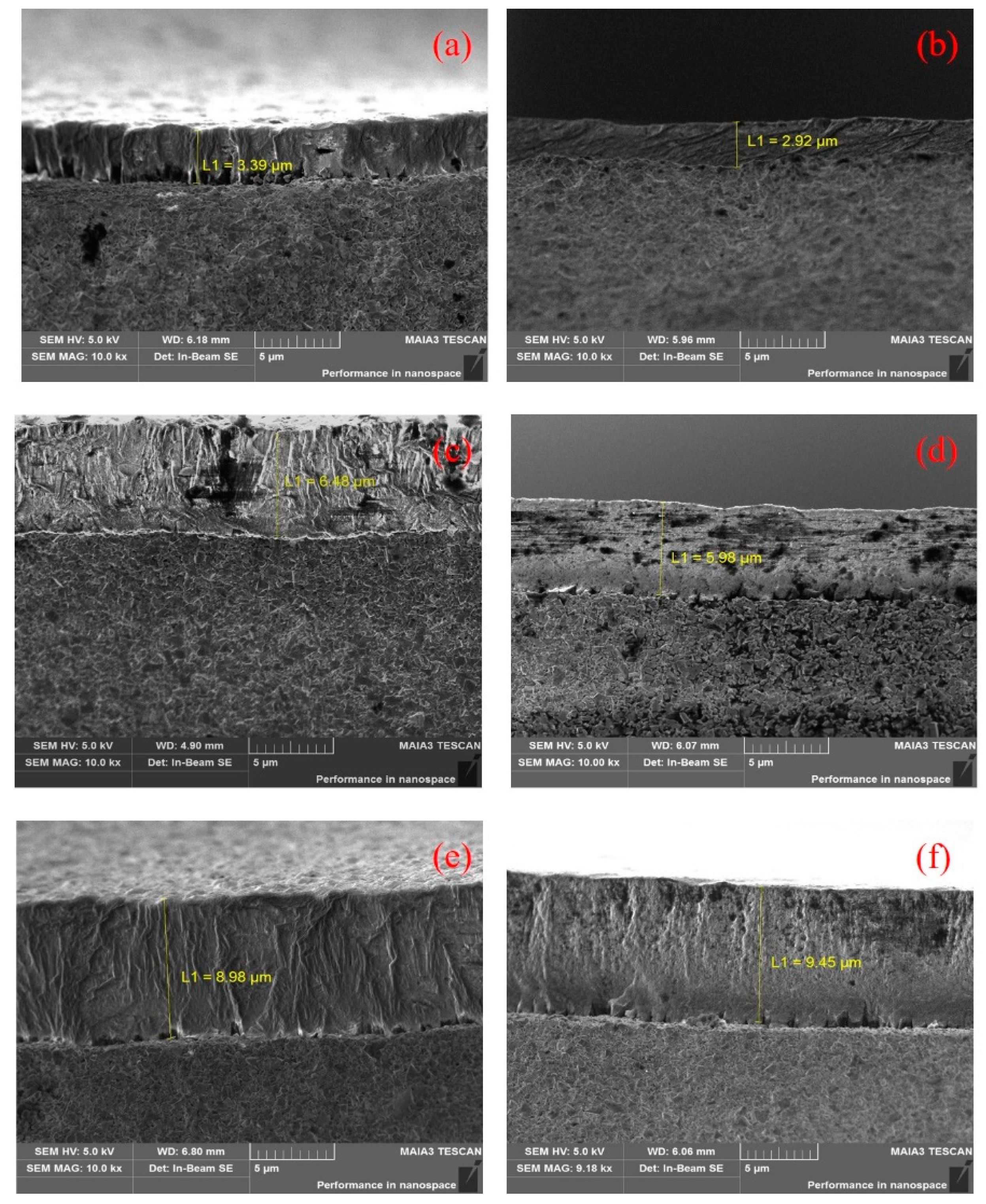

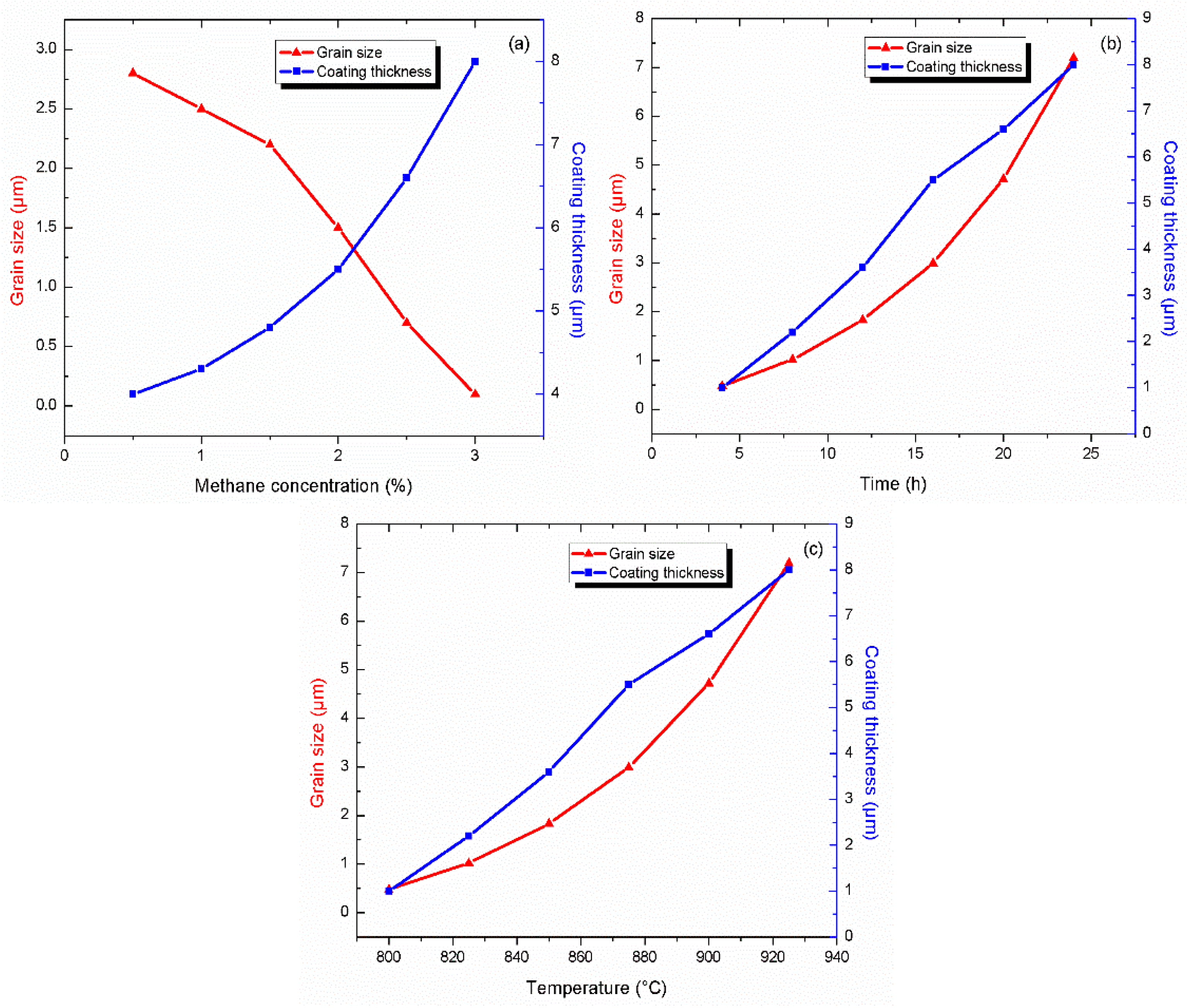


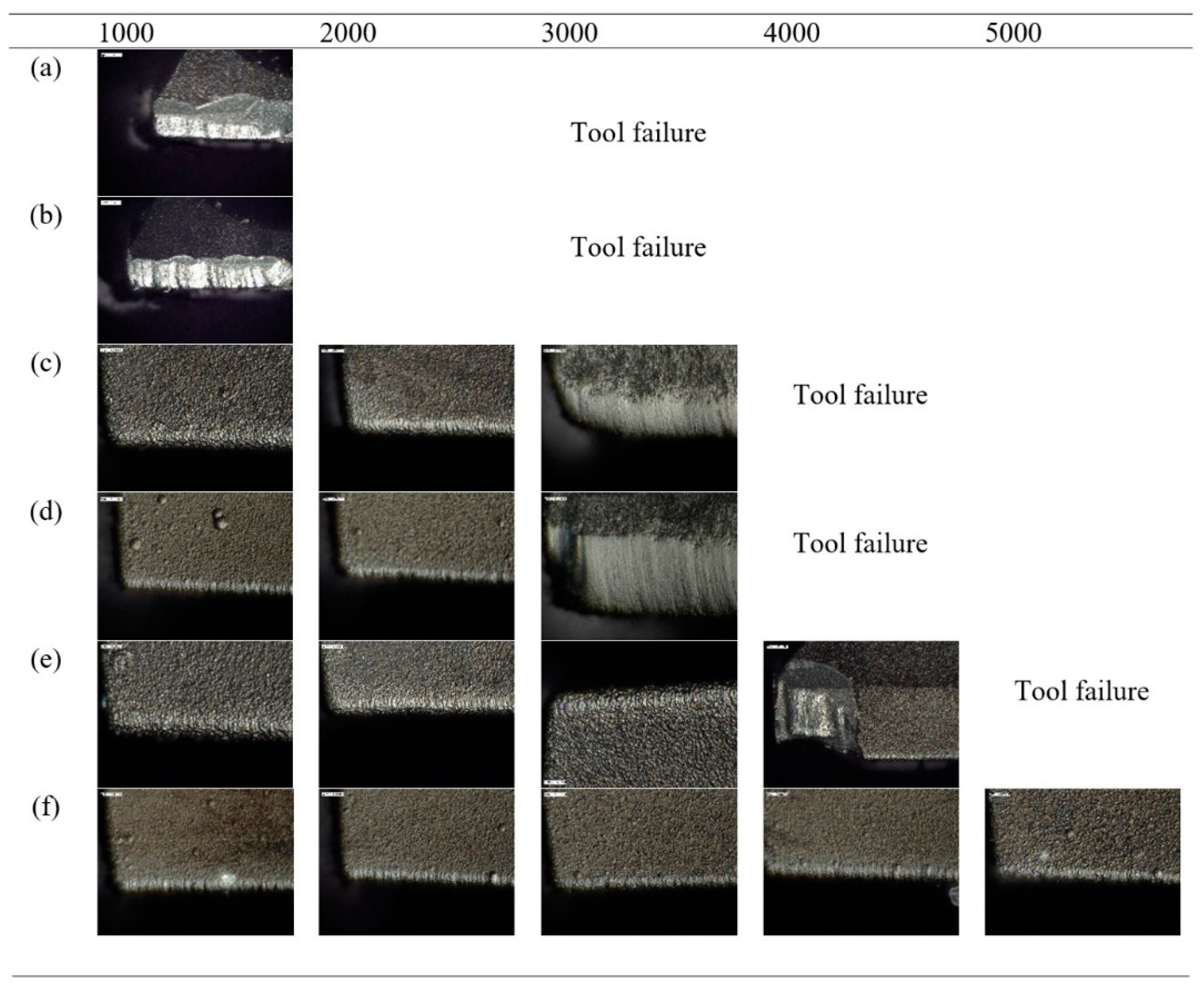
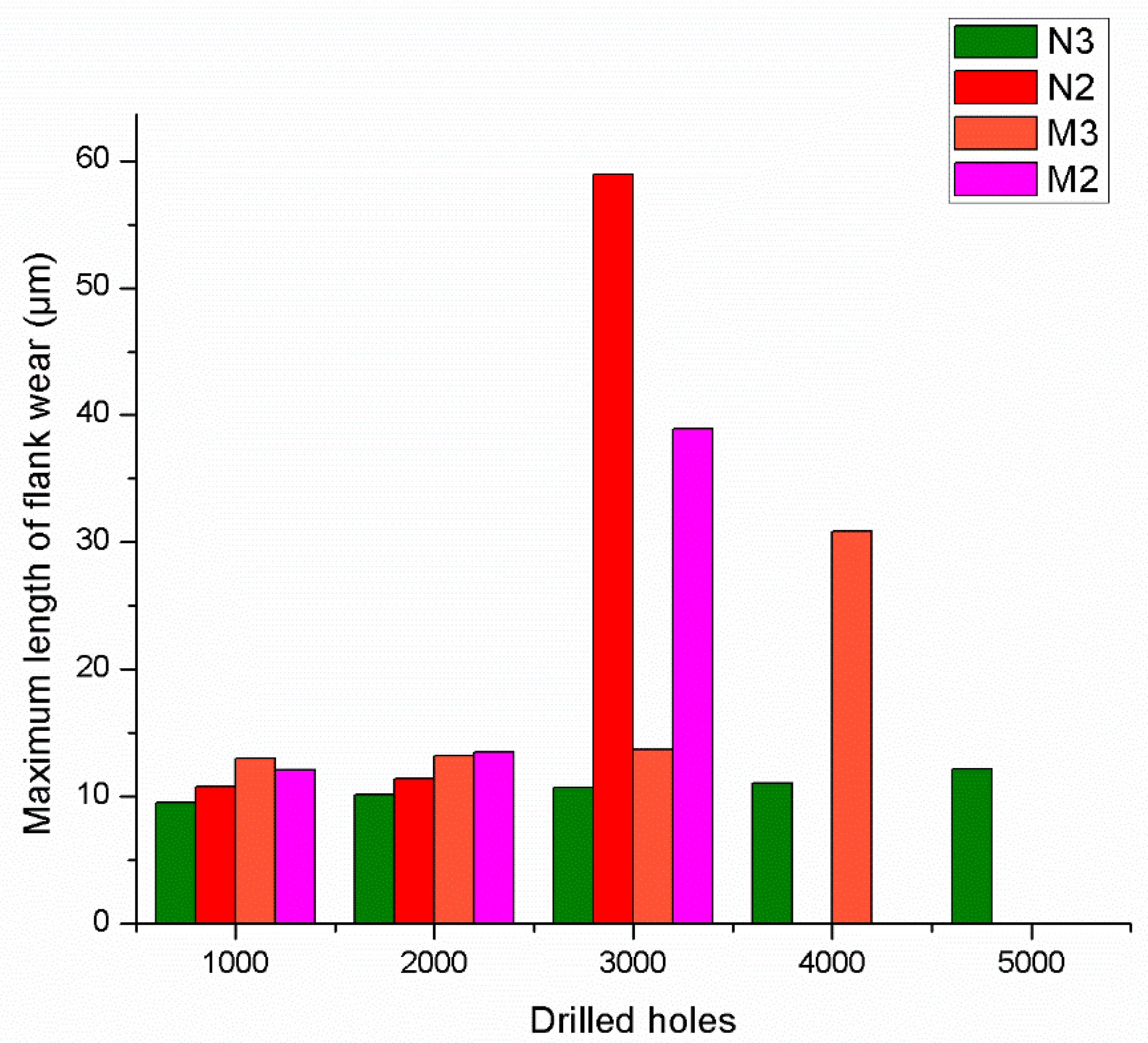
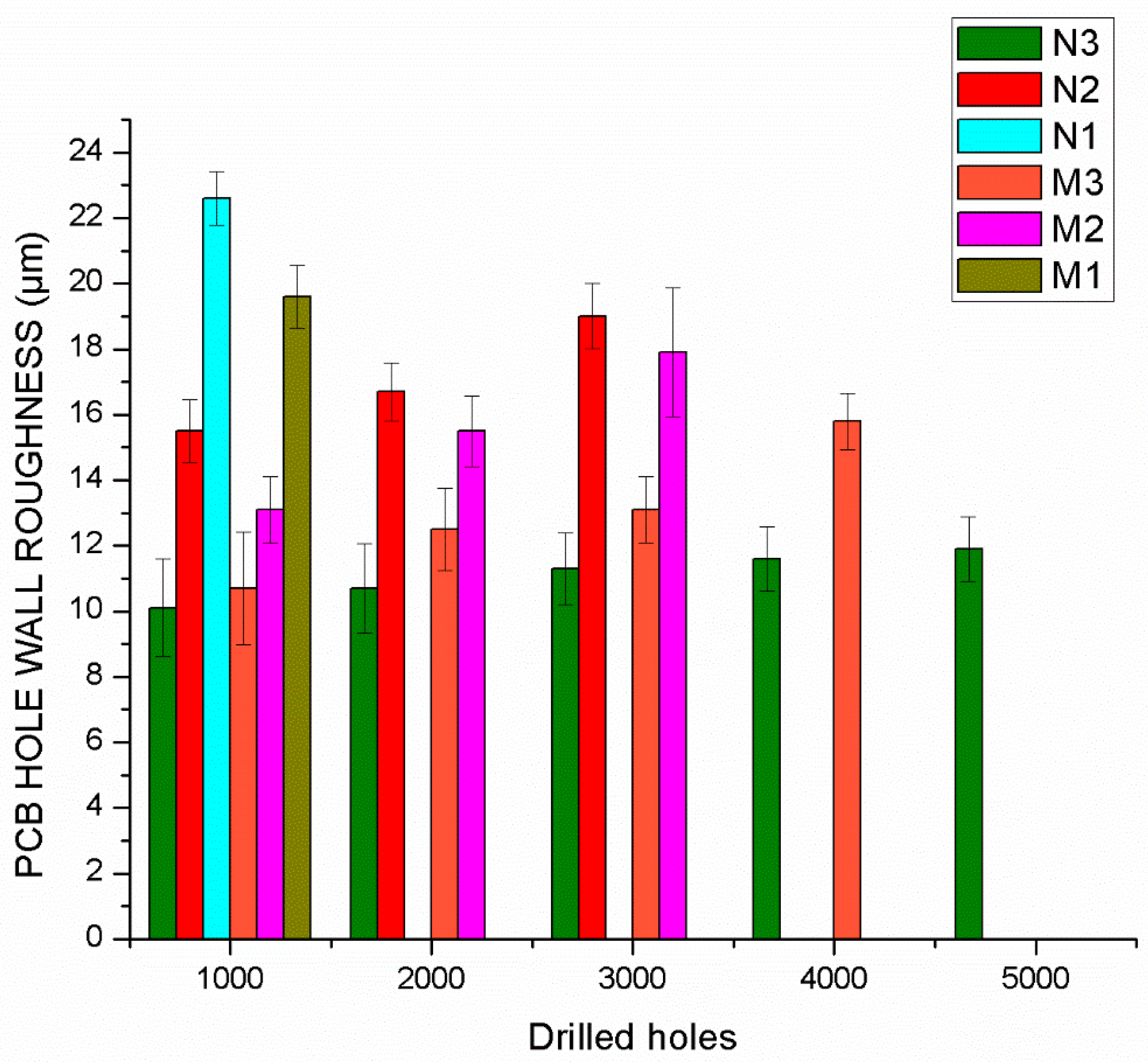
| Samples | Coating Type | Coating Thickness (μm) |
|---|---|---|
| M1 | MCD | 3 |
| M2 | MCD | 6 |
| M3 | MCD | 9 |
| N1 | NCD | 3 |
| N2 | NCD | 6 |
| N3 | NCD | 9 |
Publisher’s Note: MDPI stays neutral with regard to jurisdictional claims in published maps and institutional affiliations. |
© 2022 by the authors. Licensee MDPI, Basel, Switzerland. This article is an open access article distributed under the terms and conditions of the Creative Commons Attribution (CC BY) license (https://creativecommons.org/licenses/by/4.0/).
Share and Cite
Kwok, F.M.; Sun, Z.; Yip, W.S.; Kwok, K.Y.D.; To, S. Effects of Coating Parameters of Hot Filament Chemical Vapour Deposition on Tool Wear in Micro-Drilling of High-Frequency Printed Circuit Board. Processes 2022, 10, 1466. https://doi.org/10.3390/pr10081466
Kwok FM, Sun Z, Yip WS, Kwok KYD, To S. Effects of Coating Parameters of Hot Filament Chemical Vapour Deposition on Tool Wear in Micro-Drilling of High-Frequency Printed Circuit Board. Processes. 2022; 10(8):1466. https://doi.org/10.3390/pr10081466
Chicago/Turabian StyleKwok, Fung Ming, Zhanwen Sun, Wai Sze Yip, Kwong Yu David Kwok, and Suet To. 2022. "Effects of Coating Parameters of Hot Filament Chemical Vapour Deposition on Tool Wear in Micro-Drilling of High-Frequency Printed Circuit Board" Processes 10, no. 8: 1466. https://doi.org/10.3390/pr10081466
APA StyleKwok, F. M., Sun, Z., Yip, W. S., Kwok, K. Y. D., & To, S. (2022). Effects of Coating Parameters of Hot Filament Chemical Vapour Deposition on Tool Wear in Micro-Drilling of High-Frequency Printed Circuit Board. Processes, 10(8), 1466. https://doi.org/10.3390/pr10081466







